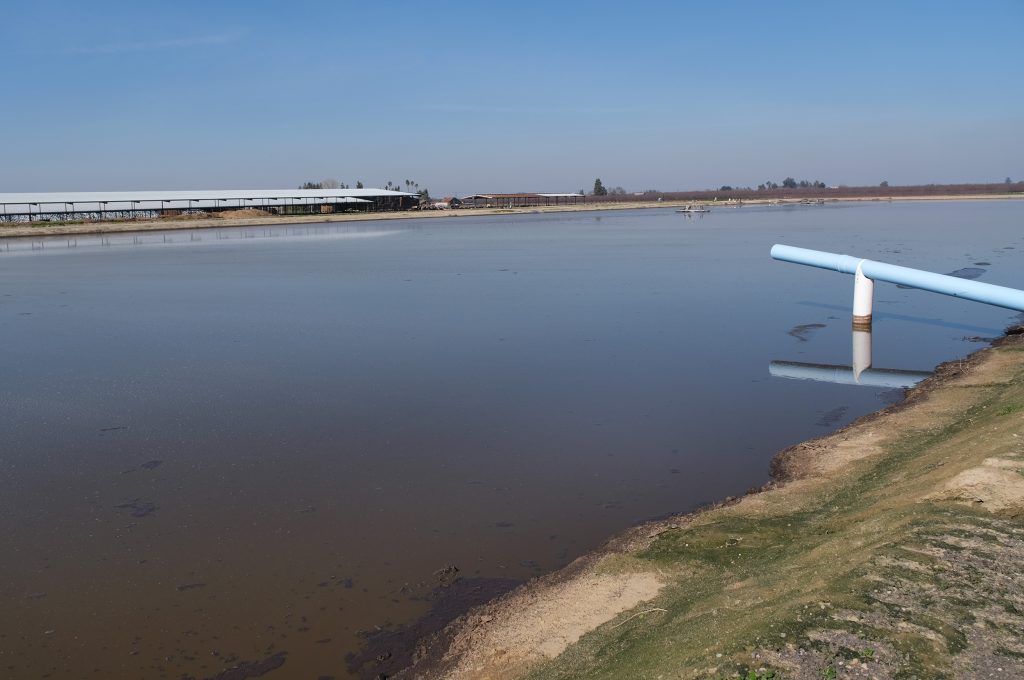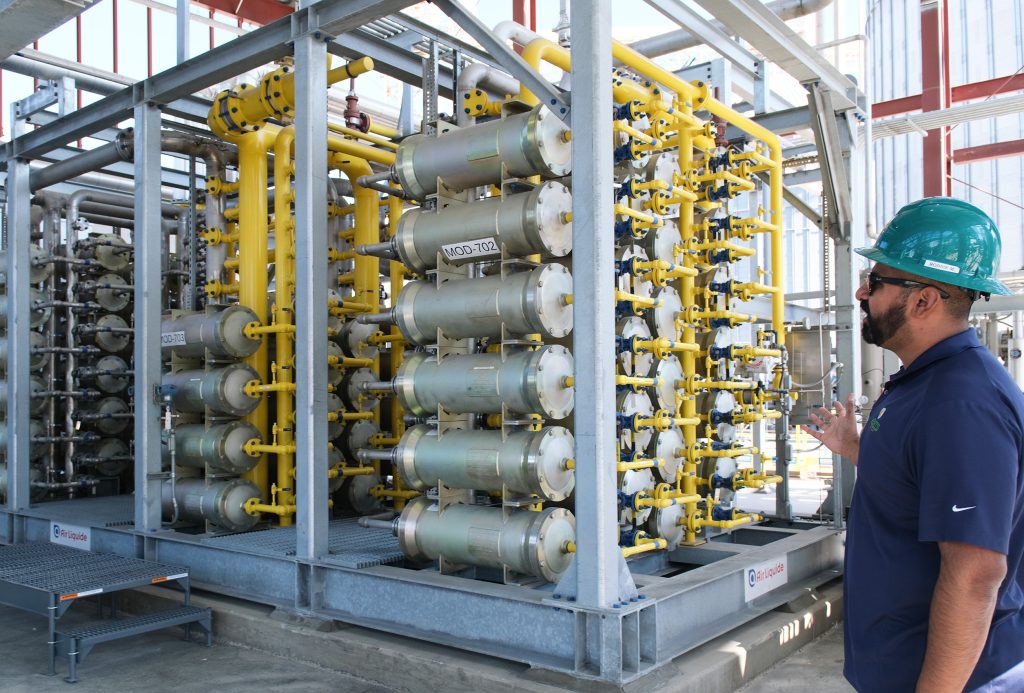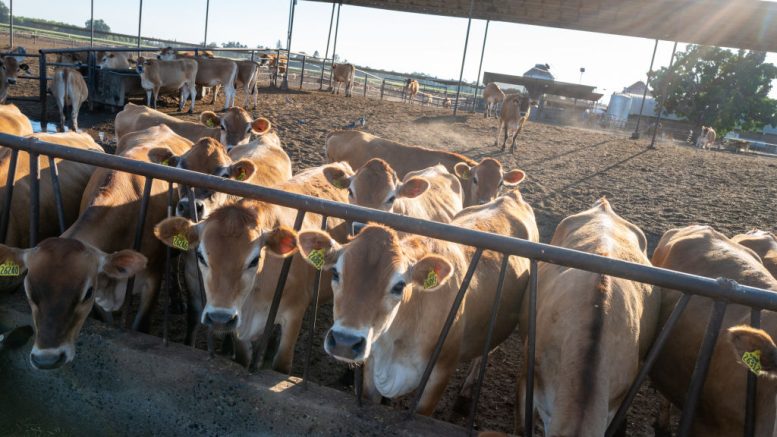Incentives for cow manure methane prop up gas infrastructure — can California do better?
By Aaron Cantu, Capital & Main
This story is produced by the award-winning journalism nonprofit Capital & Main and co-published here with permission.
As states across the country put together proposals to reduce their climate-warming pollution, the role of natural gas has been heavily debated: While gas from fossil fuels is a source of toxic emissions that drive climate change, some policy makers have touted “renewable” natural gas.
One of the most bountiful sources of renewable biogas is livestock. California, the top milk-producing state in the country, sees the manure produced by its 1.7 million dairy cows as a renewable solution because cows constantly churn out waste, and it’s considered clean because the state assumes the captured gas would otherwise go into the atmosphere.
Over the last 10 years, California has paid farmers and companies more than half a billion dollars to collect and refine cow manure vapors, raising concerns that the state is encouraging larger herds. The process has helped reduce the state’s emissions, but has come at the cost of farming communities that suffer the effects of dairies polluting air and water.
Biogas emits carbon when it’s combusted as a fuel, yet is still better for the climate compared to fossil gas. However, they share the same risks when they’re refined and combusted. Both emit pollutants when burned in a car or on a stove. And research shows biogas leaks significantly during collection and refining. This releases methane, a greenhouse gas that traps more heat in the atmosphere than carbon dioxide, straight to the atmosphere.
Biogas refining takes place at facilities like the Aemetis Advanced Fuels ethanol plant on the outskirts of Modesto. The refinery produces food for cows as a byproduct of ethanol, and the cows return the favor when Aemetis collects gas from their manure piped to the refinery from six dairy farms.
Three miles away at Ackerman Dairy, liquid manure from more than 4,000 cows flows into a lagoon covered by an airtight plastic tarp. Equipment filters out hydrogen sulfide — the chemical that makes manure smell — and sends the gas via underground pipeline to the refinery. The refined methane is fed into Pacific Gas & Electric’s gas network spanning from the Mojave Desert to the Washington state border.
Depending on your perspective, this setup represents a climate solution or a market distortion. California’s Low Carbon Fuel Standard (LCFS) program treats dairy gas as a better climate solution than electricity made from wind or solar energy. Climate groups, policy makers and other experts are challenging this approach, arguing that the state must instead regulate dairies as sources of harmful pollution.

Neither the federal government nor California direct dairies to limit methane, even though livestock are its biggest source. By propping up biomethane, California has buttressed an industry that may be worse for the climate and local environments than policymakers initially assumed.
Other states are considering a different approach: New York takes a tougher stance on regulating dairy biogas, and Oregon is considering measures to rein in factory farms. Starting next year, California will have a chance to regulate dairies more stringently. This approach could reduce methane while also protecting communities. But to do it effectively, policymakers will have to revise how they assess the impact of diaries.
What Makes Dairy Gas ‘Renewable’
In a conference room at the refinery’s office building, Aemetis Vice President of Biogas Robbie Macias described the company’s business model. It is heavily reliant on credits generated under the LCFS, through which companies earn credits from the state for selling cleaner fuel than fossil energy. Credits under the federal Renewable Fuel Standard are also important.
Some of Aemetis’ dairy gas could be routed for use in people’s homes, but the majority is intended to be used as fuel for trucks and other heavy vehicles. In cities like Los Angeles, it’s easy to spot a truck or bus with a clean natural gas CNG label. Yet, they may actually be running on traditional fossil fuel natural gas.
Truck fueling stations around California that source their natural gas from PG&E can market their product as renewable if they have a purchase agreement with a company like Aemetis. That’s true even if the gas that comes out of the nozzle is literally fossil gas. Macias used a lake as an analogy for PG&E’s infrastructure.
“If I’m on this side of the lake, and I put five new gallons of water into the lake, and you’re on the other side of the lake, and I sell you five gallons of water, you can grab water from anywhere out of the lake and it won’t be the same molecules,” Macias explained. “But technically I transported my molecules to you.”

Under these kinds of arrangements, PG&E forecasts that 10%-15% of the gas in its network will be biogas from dairies, landfills and other waste over the next decade.
Fueling stations send the majority of the credits’ value back to Aemetis. Sometimes they partner to market the credits to other polluters. LCFS credits, in particular, are lucrative because the state assumes that without the digesters, not only would the dairies emit methane, but vehicles would use more fossil diesel — so dairy gas credits are viewed as doubly climate-friendly.
The costs of installing and operating digesters far outstrip the market value of the biogas, but LCFS subsidies — which are collected via a tax on gasoline and diesel — help them pencil out. There’s a risk that incentives for capturing the gas will lead to what the agricultural economist Aaron Smith has called the “cobra effect,” where rewards for capturing a menace lead to more of the menace.
Why the State Decided to Favor Incentives Over Regulations
In 2018, the California Air Resources Board (CARB), the agency which oversees the LCFS, updated the program so that credits for dairy methane emissions into the atmosphere became more valuable when that methane was captured and sold as a fuel.
Sam Wade was chief of CARB’s transportation fuel section when the rule was drafted. He now works as a policy director at the Coalition for Renewable Natural Gas.
“The methane problem from the dairies in the state is being dealt with, and the total emissions rate is going down every year as a result of that,” Wade told Capital & Main. “That’s why the intentional choice was made to reward dairy renewable natural gas.”
In his view, requiring dairies to cut their emissions would simply result in dairies moving out of California to another state with weaker regulations. But this is based more on an assumption than evidence: CARB hasn’t studied the issue.
The agency determines whether a fuel is bad or good for the climate based on the fuel’s “carbon intensity.” Dairy gas refined by Aemetis has a carbon intensity of negative 426 — meaning it’s extremely good for the climate.
But according to Sasan Saadat, senior research and policy analyst for EarthJustice, this is just an accounting trick. Based on the same rules, an electric vehicle that charges all night using power generated by solar or wind would have a carbon intensity of zero, resulting in far less money under the LCFS than Aemetis’ dairy gas. That’s because the program considers digesters to be a net climate benefit.
“That’s obviously extremely distortionary [because] it makes it seem like dairy fuel is way better than 100% renewable electricity,” Saadat said. This could also incentivize natural gas cars over electric vehicles, a strategy that may not be best for the climate.
There are also concerns that oil and gas companies are getting involved in renewable gas to benefit from subsidies. Last year, for example, BP spent $4.1 billion to purchase Archaea, a company that produces renewable gas from landfills and livestock farms.
Digester policies allow the state to sidestep the powerful dairy and gas industries. But a growing chorus of climate and environmental advocates are calling for the state to simultaneously reduce emissions and protect communities. They say CARB must stop crediting dairies for manure gas and begin directly enforcing emissions reductions at farms. A bill currently in the California Legislature, SB 709, would change some favorable dairy gas accounting.
What California Can Learn From Other States
New York passed its first climate law in 2019, and compared to California it takes a harder line on dairy emissions and waste-to-energy projects. According to New York’s climate scoping plan approved last year, the state will limit dairy methane through alternate management and feed practices in addition to capturing it. It calls for either the destruction of dairy methane or its use as a non-combustion, low-emissions energy source to generate electricity with fuel cells.
New York’s climate plan came together under an appointed Climate Action Council that included Rob Horwath, a professor of ecology and evolutionary biology at Cornell University. When the council examined how California regulated dairy methane emissions, the group decided to take a different approach.
“We spent lots of time looking at what California has done on renewable natural gas, and we as a group reached the conclusion that California is just plain wrong on that,” Horwath told Capital & Main.
The main issue California regulators are ignoring, Horwath said, is that methane leaks into the atmosphere during biogas refining. One meta-analysis study found that leaks from wastewater treatment plants with digesters were twice as prevalent as estimates used by the International Energy Agency.
Dave Clegern, the spokesperson for CARB, said the agency currently assumes a leakage from digesters and biogas refining of 5%, far less than suggested by the study.
State regulators in California are directed under a short-lived pollutants law to consider new restrictions on dairy emissions starting next year. If the state started mandating emissions reductions outright, it could follow the lead of Oregon, where the legislature is considering bills that would place a moratorium on permits for new and expanded large dairy operations and investigate their harmful impacts.
Their passage is far from certain as dairies have mobilized to oppose it, while climate advocates are citing harmful effects as well as gaps within current regulations. People on both sides have packed hearings on the bills, according to Tarah Heinzen, legal director at Food & Water Watch. It’s the third time they’ve tried to pass legislation. As in California, communities near dairies in Oregon tend to be lower income and disproportionately Latino.
“You don’t see this type of crisis unfolding in wealthier parts of the state,” Heinzen told Capital & Main.
Changes to how California assesses the climate effects of dairies could impact farms nationwide, because dairies in several states participate in the state’s climate market programs. In addition to the LCFS, dozens of dairies across the country participate in California’s cap and trade program, earning revenue by selling pollution offset credits. But after environmentalists in Wisconsin and Iowa found evidence that several dairies violated clean groundwater laws, CARB invalidated offset credits valued at roughly $500,000-$1 million.
Macias, the VP at Aemetis, disagrees with much of the criticism of renewable gas. He acknowledges that changes to dairy biogas crediting could devastate his company’s bottom line, but he is still committed to the production of renewable gas, which he sees as a service.
The industry thinks biogas has a role in the energy mix. Gas from landfill garbage and other waste collected by a digester can be a method of recycling energy, they say. California’s climate plan contemplates burning biogas for making steel and cement, but there’s a potentially cleaner option, as forecast by New York state, in which it could be used in fuel cells to generate electricity. That would depend on a lot of breakthroughs and subsidies.
As policymakers and advocates struggle for solutions, Macias views his role as essential to the fight against climate change. A lifelong resident of the Central Valley, he dismisses claims that his industry doesn’t care about his community.
“Am I going to make a difference in the world?” Macias asked. “I sure as hell hope so, but I know I’m making a difference here, and so beyond all the economics, I think our community deserves more, and if we can have a part of that in this state, that’s awesome.”
Copyright 2023 Capital & Main


Be the first to comment on "California’s methane climate solution rewards dairy gas: Other states take a harder line"